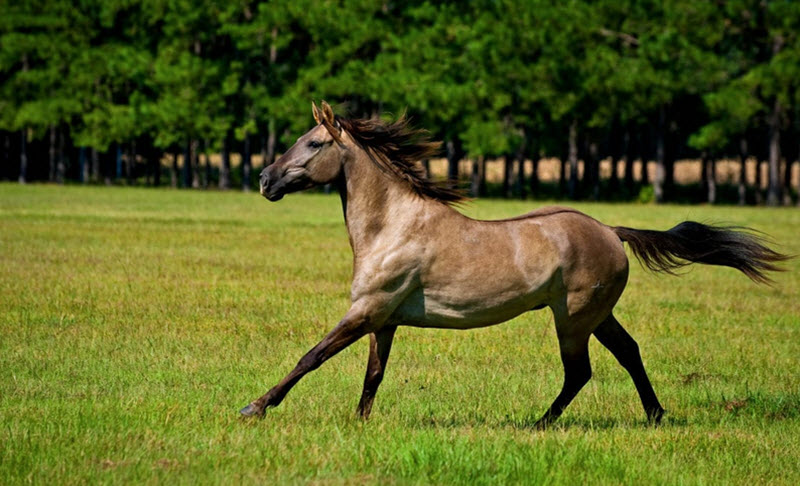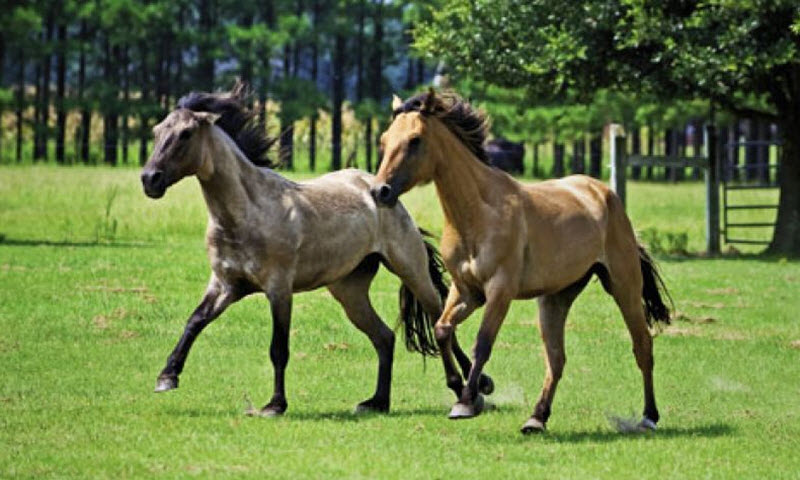Contents
The Carolina Marsh Tacky was developed for work in the lowland waterways and swamps of coastal South Carolina where being sure-footed is of imperative importance. This is a fairly small horse (13-15 hands), with most individuals staying around 14 hands. It is an easy keeper, which means that it doesn´t need a lot of food to do well.
Nowadays, Marsh Tackys is a popular choice for hunting trips, endurance riding and cattle herding. They are excellent beach horses, and during World War II, Marsh Tackies were used to patrol the beaches of South Carolina.
As a part of the annual Gullah Cultural Festival in Beaufort SC on Memorial Day weekend, Marsh Tacky races are held on the beach each year. The Gullah is an African-American group that, since the end of the American Civil War, has been using Marsh Tackys to work their fields and gardens on islands located off the South Carolina mainland.
Since 2010, the Carolina Marsh Tacky is the State Heritage Horse of South Carolina.

The Carolina Marsh Tacky Association
During the second half of the 20th century, the Marsh Tacky became a rare horse breed because its traditional jobs were now carried out using motorized vehicles instead. In 2007, the Carolina Marsh Tacky Association was created in an effort to help promote the breed and save it from extinction.
Breed registry
The Carolina Marsh Tacky registry is maintained by the American Livestock Breeds Conservancy Pedigree Registry.
The studbook was closed in 2010, but it is still possible to register outside horses if they fulfil all the requirements. (Parentage must be confirmed with a DNA test.)
Temperament
The Carolina Marsh Tacky has a gentle disposition. Historically, it was considered an ideal riding horse for women and children because of its diminutive stature and pleasant temperament.
Ambling gait
The Carolina Marsh Tacky is capable of carrying out a four-beat ambling gait with diagonal foot pairings that creates a brief moment of all four feet being on the ground at the same time (quadrupedal support).
How big is a Carolina Marsh Tacky?
This is a fairly small horse that stays within the 13-15 hand span. Most individuals are around 14 hands.
Colours
Carolina Marsh Tacky horses come in a wide range of colours, including black, dun, bay, grullo, roan, and chestnut. Pinto and similar multi-coloured patterns existed in the breed in the past but have now been bred out.
Head & Body
The Carolina Marsh Tacky features long and angled shoulders, pronounced withers, a short and strong back, and a steeply angled croup. The chest is narrow but deep. The legs have long, tapering muscling.
The neck is attached rather low on the chest. The head is flat or just a bit concave, turning convex from the nasal region to the top of the muzzle. The forehead is wide and the eyes are set far from each other.
Background
The Carolina Marsh Tacky partly hails from horses brought over to America by Spanish explorers during the colonial era.
For a while in the past, it became common for traders to buy horses in Saint Augustine, Florida (which was then a Spanish controlled settlement), let them carry the goods along the Native American trade routes, and then sell them once they had reached Charleston, South Carolina. Around Charleston, large herds of feral and semi-feral horses developed. From these herds, which were largely left to fend for themselves, horses were taken as needed.

The Marsh Tacky & the American Revolution
During the American Revolution, the British cavalry used large English horses. These horses were fast and powerful, but ill-suited to moving around in swampy environments along the coast. The irregular United States forces headed by Francis “Swamp Fox” Marion used Carolina Marsh Tackys instead, which gave them an advantage in the difficult terrain.
Why is it called Marsh Tacky?
The first part of the name is easy to understand: this horse breed is perfect for work in marshlands and similar coastal environments. But why tacky? Historically, this was the most common horse in the coastal lowlands of South Carolina and Georgia. The word tacky can be used to denote something that is common and/or cheap, and these horses were both low-priced and very widespread in the region back in the days.
Related breeds
The Carolina Marsh Tacky is a fairly close relative of the Florida Cracker horse and the North Carolina Banker horse.
